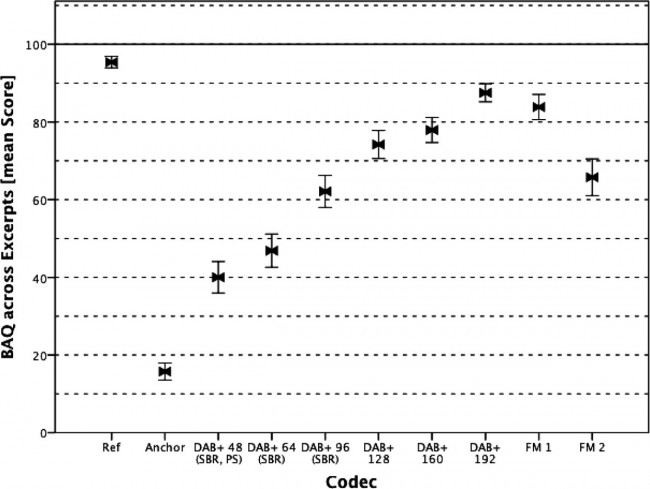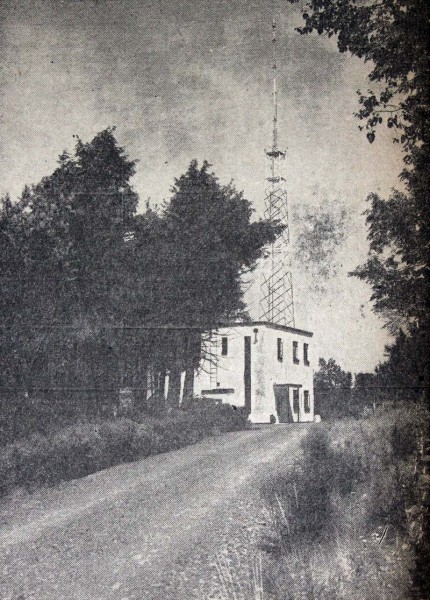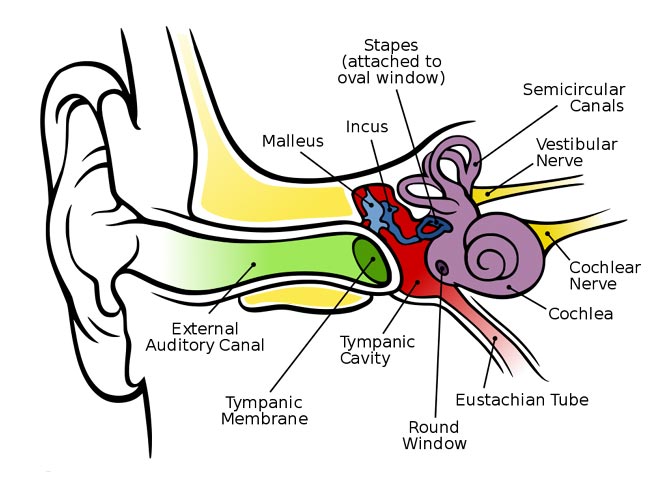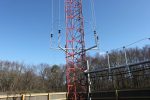As it turns out, 300 kbp/s or greater. At least in critical listening environments according to the paper titled Perceived Audio Quality of Realistic FM and DAB+ Radio Broadcasting Systems (.pdf) published by the Journal of the Audio Engineering Society. This work was done by a group in Sweden that made various observations with different program material and listening subjects. Each person was given a sample of analog FM audio to listen to, then they listened to various audio selections which were using bit reduction algorithms (AKA CODEC or Compression) and graded each one. The methodology is very thorough and there is little left for subjective interpretation.
In less critical listening environments, bit rates of 160-192 kbp/s will work.
I made a chart and added HD Radio’s proprietary CODEC HDC, which is similar to, but not compatible with AAC:
| System | Codec | Bit Rate (kbp/s) |
| HD Radio FM; HD1 channel* | HDC (similar to AAC) | 96 – 144 |
| HD Radio FM; HD2 channel* | HDC | 24-48 |
| HD Radio FM; HD3 channel* | HDC | 24-48 |
| HD Radio AM* | HDC | 20-60 |
| DRM30 (MF-HF) | AAC/HE-AAC | 34-72 |
| DRM+ (VHF) | AAC/HE-AAC | 700 |
| DAB+ | AAC/HE-AAC | 32 – 128 |
| DAB | MPEG II, Dolby Digital | 192 – 256 |
| Blu-ray | PCM** | ≥6 Mbp/s |
| DVD | PCM, DTS, Dolby Digital | >800 |
| CD-A | PCM | 1,411 |
| Web Streaming | MPEG I,II,III, WMA, AAC, etc | 32-320, 128 typical |
| iTunes | AAC | 128 – 256 |
| Spotify | Ogg Vorbis | 96 – 320 |
| Wimp | AAC/HE-AAC | 64 – 256 |
*Hybrid mode
**PCM: uncompressed data
This is the composite Mean Basic Audio Quality and 95% confidence intervals for the system across all excerpts:

Over the years, we have simply become accustomed to and now accept low-quality audio from mp3 files being played over cheap computer speakers or through cheap ear buds. Does this make it right? In our drive to take something good and make it better, perhaps it should be, you know: Better.
Special thanks to Trevor from Surrey Electronics Limited.






Maybe it’s a matter of “compared to what,” but using a Sony HD tuner, the local 50 kW AM that runs HD undergoes an amazing transformation as the receiver syncs up — the noise floor drops, the high end opens up and the low end unmuddies, while the sound field expands.
The contrast with the lousy-but-listenable regular signal is really staggering. If you had plenty of signal and not much noise, a really good AM tuner could come close, especially back before preemphasis came to AM, though usually getting good sound on more than the very nearest station took an outdoor antenna of some size.
The content on the local high-powwer HD AM is still a relatively uninspired sports format. The quality is improved but there’s still nothing there for me. Now, if only the system could only work the same magic with the very non-local college AMer from Purdue….
Still, I do think HD AM sounds markedly better than plain old AM on modern hardware. But so did AM Stereo. We keep proving that no matter how we fiddle with signal quality, people stay away in droves if there’s nothing there they want to hear.
As far as audio is concerned it seems like we passed ‘peak fidelity’ some time ago. Back in the analog days, hi-fi meant that the transcription and playback system had to aim for actual physical duplication of the original sound or waveform. With digital audio, various forms of psychoacoustic masking and other perceptual tricks fool the listener’s brain with the illusion of high fidelity.
Bandwidth is money. The marketplace is telling us old timers that simulated sound is OK as long as there are millions of channels to choose from. When we’re gone nobody will remember what hi-fi was all about.
Another aspect of this cultural shift is the fact that the actual experience of ‘natural sound’ in music and the performing arts is becoming increasingly rare. Symphonic concerts with no amplification are attended mostly by the elderly. Younger ears rarely experience public sounds that are unmodified by microphones, amplifiers, speakers, earbuds, equalization, effects, codecs or other forms of distortion and enhancement. At home, the acoustic environment is generally muddled by background audio and mechanical noise sources. Even face-to-face conversation is getting scarcer in an artificial environment of phoning, texting and Facebooking.
I think Lee brings up some very interesting observations. I remember growing up and being exposed to people who had a love of sound and this inspired me to become an audiophile, saving up to purchase quality audio components for a home sound system. Today, young people listen to music of varying quality from a multitude of sources and often play it back on inferior equipment such as cheap earbuds and portable players that are far from audiophile quality. Audio quality has taken a back seat to just having the noise available. Something Lee didn’t mention was the culture of listening to music has changed, too. Placing a record on the turntable, cleaning it and then placing the tonearm on it was part of the experience in addition to “getting lost” in the liner notes and reading them – even if you’ve read them countless times. This experience started going away with the CD as packaging started getting less and less.
@Roberta: You’re on the money when it comes to content being king, but I really think HD was something we could have lived without. I remember listening to the AM station I would eventually engineer on a Sony SRF-A1 Walkman back when the station installed their Kahn AM Stereo system. I had to do a double-take to make sure I wasn’t listening to FM. The audio quality was phenomenal and it was hard to believe AM could sound that good. Analog AM started heading downhill with the NRSC-1 mask and manufacturers making their AM radios sound like junk.
Codecs are like the Matrix to me… once you hear it working you can’t unhear it!! Even at very high bitrates I can hear the tell-tale metallic sound of AAC. Forget about MP3.
If you ever want to hear all the crap that is being “masked” by your favorite lossy codec of choice, listen to the L-R of the file. All the swishing, swirling and garbled mess is contained there. For an FM situation using compressed music files or a compressed STL, all that garbage is going in your L-R subcarrier. All that’s doing is increasing the chance for more multipath.
Uncompressed files, uncompressed STL and a good analog FM exciter can sound amazing. Sadly, the digital versions, while quieter with weak signal, will not have the same “depth” that analog has. As for AM HD, I can’t take the SBR that is on the codec. I’d rather listen to mellow, warm 4k audio than screechy “HD” audio.
The absolute best sound reproduction I’ve experienced in my home was a live studio broadcast over uncompressed FM with pure analogue in the signal path (KKUP in Silicon Valley). It beats vinyl and hi res digital even.
FM is capable of wonderful things. Too bad it is losing market share to low quality sound.
Has anyone actually put this to the test with a home FM transmitter?
I did with the Ramsey FM transmitter.
The best answer I can come up with is that there is no answer using MP2, MP3, or AAC compression: the only direct analog of the analog signal is PCM waveform.
You can adjust the sample rate and bit depth to be close to FM quality.
I found that 128 kbps is equivalent to poor stereo reception environments, and 64 kbps is equivalent to poor mono reception environments, and CD quality bit rate is needed for the best reception environments.
What I did:
(1) Imported wb stereo track that was already processed.
Audio compression (audio processing) before bit rate reduction is a critical feature of all lossy compression systems that use masking.
The bass parametric EQ used in commerical FM broadcast stations creates masking to make you less notice how bad it sounds. Compare how much worse my nb mono track without bass sounds compared to my nb stereo track with mega bass.
(2) Equalization to give a sharp 20 db cut to all frequencies above 4 khz. Curve puts 4 khz at -12 db and 3.5 khz at -6 db.
Pass filters is a critical feature of any digital audio system before sampling to limit the audio bandwidth to less than half the sample rate.
(3) Exported at 48 khz sample rate because 48 is a multiple of 8.
(4) Import the export and export as 8 khz sample rate.
*Disclaimer: Exporting a 48 khz sample rate import to 8 khz sample rate will make the file exactly 6 times larger and exactly 6 times longer. So it doesn’t work. At least this way. The laws of physics say that frequency is inversely proportional to time domain. So the lower the frequency the greater the time domain.
**Work around: Use the “resample” feature in the “Tracks” menu in Audacity. Two files have audio processing done on them while this algorithm is performed, instead of just one.
Likely a “Discrete Cosine Transform” is performed that does not require the time domain. DCT is used in MP3 encoder (and even MPEG video and JPEG image as light is similarly sampled at frequencies) for similar reasons, to not sample frequenices that can’t be perceived.
(5) Export as 8 bit for the bit depth.
The file should be now compressed to 128 kbps.
If the file isn’t 128kbps, something went wrong. Check to see if “Project Rate” in the bottome left corner of the screen in Audacity is also set to 8 khz. If the project rate is 48 khz and the sample rate is 8 khz, the exported file will have 48 khz sample rate. Pointless to export frequencies that don’t exist, but the computer doesn’t understand what “frequency” is it just does what its told to do.
So now we’re at 128 kbps. Note that the bit rate is too low to sample higher frequencies. Double the bit rate would allow double the sample rate.
(6) Encode with FLAC for lossless compression techniques to reduce the bit rate 50%.
***Discalimer: Tipard Total Media Converter’s FLAC encoder only supports 16 bit for the bit depth.
The sample rate could be increased by 150% to 20 khz, then after FLAC encoding the bit rate would be 256 kbps to have 20 khz sample rate and 8 bit depth.
256 kbps MP2 encoder is similar to this because it is very simple encoder.
128 kbps MP3 encoder is more complicated to achieve the same quality at half the bit rate.
96 kbps AAC encoder can acheive the same quality at a 50% lower bit rate because AAC is 50% more efficient than MP3. This is rarely done for music except on HD Radio and 360p YouTube videos, usually 128 kbps AAC is used for greater quality at the same bit rate as MP3.
A 128 kbps MP3 file compared to this 128 kbps file will have more high frequency sounds reproduced in the MP3 file.
Pretty good still, its hard to tell the difference between the CD quality bit rate file that has audio processing done on it and the nb stereo 128 kbps file in bass heavy parts. Artifacts become obvious in high frequency parts of songs… when listening to the file on a file player with headphones in a silent room. The artifacts are much less obvious when FM transmission is used and the listening environment is a noisy car.
My perception is that bass heavy 0 hz to 3.4 khz audio bandwidth with good stereo separation is acceptable quality comparable to the point at which the stereo LED starts flickering on and off. Remember that the L-R difference signal received is usually much less than 15 khz bandwidth in poor stereo reception areas. Reducing the audio bandwidth is actually important to reduce static.
Certainly all these features could be implemented on receivers without having to transmit separate files, but in practice it is not done because of cost. It is rare for modern receivers to have a bandwidth control and a stereo/mono switch. HD Radio partially solves this problem with lower quality bit rates when the higher quality bit rate can’t be received, but the higher quality bit rate is itself already so low quality due to sub channels that lower quality bit rates are inferior to analog FM sound.
The wide band file can be played when there is good stereo reception.
The mono file can be switched to when the stereo LED is flickering on and off to sound less annoying. The mono file is designed to allow for more pre-emphasis of the mids frequencies undistorted by bass, so bass is removed. No greater pre-emphasis is actually used in the mono file however, just you can turn the radio up louder to be louder than the static because the bass is removed.
There is no limit on internet streaming actually. I regularily stream 1411 and 1536kbps FLAC streamers.